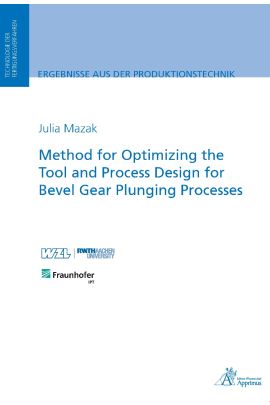For manufacturing bevel gears, a special tool system consisting of cutterhead and removable stick blades is used. This tool system produces multi-flank chips which are of complex, three-dimensional geometry. Therefore, the process and machine kinematics are subject to a sophisticated predefinition.
Existing, empirical wear models for bevel gear cutting are limited to discontinuous plunging. Furthermore, no validated, simulative process analysis for bevel gears exists so far. The objective of this thesis was to optimize the process for continuous and discontinuous plunging for bevel gear cutting regarding tool life based on tool angles and process parameters. For this purpose, a wear model was developed that is based on the elastic deformation of the workpiece and regards the thrust force. The influence of the rake angle on the thrust force was modelled by means of the shear angle.
First, it was investigated whether the planar-based penetration algorithm is suitable for determining the geometric-kinematic characteristics of plunging. The results of the planar-based penetration algorithms were plausible. The qualitative comparison of the simulated, undeformed chip geometry to actual chips of cutting trials was successful. The simulated chips matched the actual chips in both shape and proportions. For all processes, the deviation between the simulated flank and the target flank was below 1 µm.
In cutting trials, the influence of the varied process parameters and tool angles as well as the influence of the combination of these factors on tool wear was quantified. No clear basic mathematical relationship could be established for the results.
The developed model was applied to the results of the cutting trials combining feed ramp and tool angle variation. These results had not been used for determining the model parameters. The equivalence tests for the model results were successful, thus validating the model.
In order to find out which constraints there are for an application of the optimization method to continuous plunging, the model was transferred to a continuous plunging sample gear. Measured and simulated tool wear match and optimization potential for the investigated gear was presented.
| Autor | Mazak, Julia |
|---|---|
| Gewicht | 0.31 kg |
| Erscheinungsdatum | 17.06.2021 |
Eigene Bewertung schreiben
Technologie der Fertigungsverfahren
Method for Optimizing the Tool and Process Design for Bevel Gear Plunging Processes
ISBN: 978-3-86359-973-7
Lieferzeit: 2-3 Tage
39,00 €
inkl. 7% MwSt.
Kurzbeschreibung
For manufacturing bevel gears, a special tool system consisting of cutterhead and removable blades produces multi-flank chips which are of complex, three-dimensional geometry. The objective of this thesis was to optimize the manufacturing process for continuous and discontinuous plunging for bevel gear cutting regarding tool life based on tool angles and process parameters. For this purpose, a wear model was developed that is based on the elastic deformation of the workpiece.
Auf Lager

